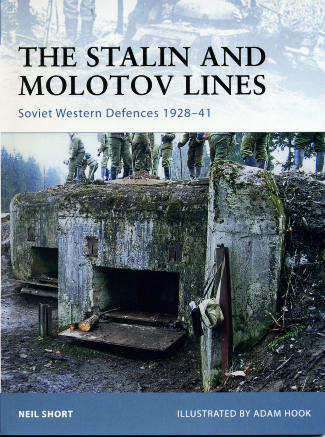 Fortress
#77 covers the defensive structures that were built by the Soviet Union between
1928 and 1941. Initially, the Soviets saw that they needed to build up defensive
positions along its western borders to prevent incursions from the many
unfriendly nations that were next to it. However, the new nation was woefully
short of funds to build what had to be a massive undertaking due to the huge
area that needed defended.
Fortress
#77 covers the defensive structures that were built by the Soviet Union between
1928 and 1941. Initially, the Soviets saw that they needed to build up defensive
positions along its western borders to prevent incursions from the many
unfriendly nations that were next to it. However, the new nation was woefully
short of funds to build what had to be a massive undertaking due to the huge
area that needed defended.
Rather than a continuous line of defenses, they started
building defensive positions in what were known as fortified regions. Initially,
there was little motivation to start construction, but by the late 1920's there
was a real war scare and building began in earnest. Once the major fortified
regions were nearing completion, other regions in between were started and so
on. By the time of the late 1930s, all of the major areas were fortified, and to
some extent the minor ones as well. Of course, there were the usual problems
with substandard building materials, lack of weapons to install in the various
bunkers and lack of soldiers to operate these weapons. All of this was known as
the Stalin Line.
When Poland was partitioned and the Baltic states overtaken
in 1939/1940, a new border was formed and that needed to be defended. Many of
the older Stalin line facilities were stripped of their weapons and a new round
of construction began. This was the Molotov line. Same old problems of
construction, equipment and manning. When the Germans invaded in 1941, the
Soviets were, for the most part, unable to man the new defensive positions and
with few exceptions, these were quickly over run. The older Stalin line
positions, however, were put to more use and several held out for quite some
time. As they were facing west, they were of little use to the Germans during
their long retreat.
Author Neil Short covers the design and development of these
positions, some of which were simply machine gun, some of which had artillery
and some that used old tank turrets. Each of these various types are given a
detailed look in regards to how they were set up and their use. A look at those
who built and manned these sites is included as well as their operational use.
Interestingly, many of these are still extant and in fairly good condition.
Aside from Belarus, few have been restored, though the Russians are working
towards saving some.
All of this is additionally enhanced by period photos, images
of the extant sites and the superb art work of Adam Hook. The book will be
especially useful to the modeler who likes to do dioramas as there are a nearly
unlimited number of possibilities shown in these pages.
Overall, another fine book in this series and one that should
be on the shelves of anyone interested in this particular time and place in
history.
September 2008
For more on the complete line of Osprey books,
visit www.ospreypublishing.com. In the US, it is
Osprey Direct at 44-02 23rd St, Suite 219, Long Island City, NY 11101., where you can
get a catalogue of available books.
If you would like your product reviewed fairly and quickly, please contact
me or see other details in the Note to
Contributors.
 Fortress
#77 covers the defensive structures that were built by the Soviet Union between
1928 and 1941. Initially, the Soviets saw that they needed to build up defensive
positions along its western borders to prevent incursions from the many
unfriendly nations that were next to it. However, the new nation was woefully
short of funds to build what had to be a massive undertaking due to the huge
area that needed defended.
Fortress
#77 covers the defensive structures that were built by the Soviet Union between
1928 and 1941. Initially, the Soviets saw that they needed to build up defensive
positions along its western borders to prevent incursions from the many
unfriendly nations that were next to it. However, the new nation was woefully
short of funds to build what had to be a massive undertaking due to the huge
area that needed defended.